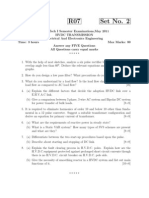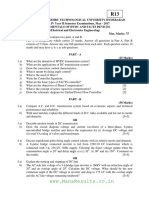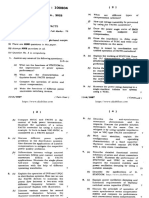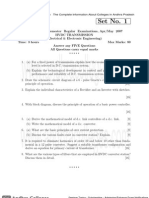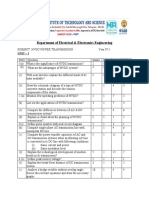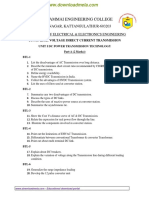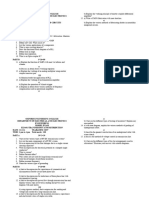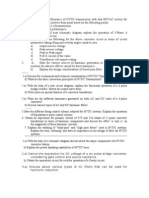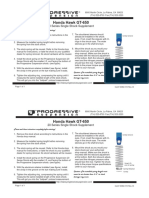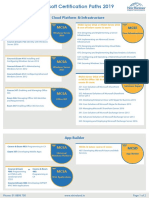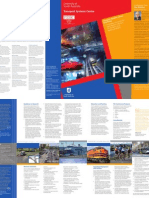Fundamental of HVDC FACTS Devices
Fundamental of HVDC FACTS Devices
Uploaded by
gauthamCopyright:
Available Formats
Fundamental of HVDC FACTS Devices
Fundamental of HVDC FACTS Devices
Uploaded by
gauthamOriginal Description:
Copyright
Available Formats
Share this document
Did you find this document useful?
Is this content inappropriate?
Copyright:
Available Formats
Fundamental of HVDC FACTS Devices
Fundamental of HVDC FACTS Devices
Uploaded by
gauthamCopyright:
Available Formats
www.jntuworld.com || www.android.jntuworld.com || www.jwjobs.net || www.android.jwjobs.
net
1
Code: 9A02702
B.Tech IV Year I Semester (R09) Regular & Supplementary Examinations December/January 2013/14
FUNDAMENTAL OF HVDC & FACTS DEVICES
(Electrical & Electronics Engineering)
Time: 3 hours
Max. Marks: 70
Answer any FIVE questions
All questions carry equal marks
*****
1 (a)
(b)
Draw schematic diagram of a typical HVDC converter station and explain the functions of
various components available.
Prove that insulation required for a bipolar D.C. system is 0.866 times that required for 3-phase,
3 wire A.C. system. Assume that power transmitted, percentage losses and size of conductors
are same for both systems.
D
L
R
O
2 (a)
(b)
Explain in detail the converter control characteristics of HVDC systems.
Explain the effect of source inductance on HVDC systems.
3 (a)
(b)
Discuss about characteristic and non-characteristic harmonics generated in HVDC systems.
What are the adverse affects of harmonics produced by the HVDC converters?
4 (a)
(b)
Explain the sequential method for AC-DC power flow.
Derive the mathematical model of a HVDC converter.
Explain the basic types of the FACTS controllers and their applications.
6 (a)
Explain how the shunt compensation is useful in prevention of voltage instability and
improvement of transient stability.
Explain the basic operating principle of TCR and its characteristics.
(b)
W
U
T
N
Explain the operation and characteristics of GTO thyristor controlled series capacitor.
8 (a)
(b)
Explain the basic operating principles of UPFC.
Explain how the UPFC can control real and reactive power flow in the transmission line.
*****
www.jntuworld.com || www.jwjobs.net
www.jntuworld.com || www.android.jntuworld.com || www.jwjobs.net || www.android.jwjobs.net
2
Code: 9A02702
B.Tech IV Year I Semester (R09) Regular & Supplementary Examinations December/January 2013/14
FUNDAMENTAL OF HVDC & FACTS DEVICES
(Electrical & Electronics Engineering)
Time: 3 hours
Max. Marks: 70
Answer any FIVE questions
All questions carry equal marks
*****
1 (a)
(b)
Prove that the average valve rating of a 3-phase, two way bridge rectifier is 2.094 Pd with
the help of a relevant waveforms, where Pd is the D.C. power. Mention the assumptions
made.
What are the merits & demerits of HVDC power transmission?
D
L
2 (a)
(b)
Explain the principles of DC link control in HVDC system.
Explain clearly the procedure for start up of a DC link.
Explain the different methods of compensation of reactive power in HVDC substation with
neat single line schematics.
Derive and explain the solution of AC/DC load flow problem using simultaneous method.
5 (a)
(b)
Explain the concept of power flow n parallel paths and meshed systems.
Explain the loading capability limits.
6 (a)
(b)
Explain the operation of TCR and TSR with their characteristics.
Explain how the TCR and TSR can eliminate the harmonics in the system.
Explain the basic control schemes for GSC, TSSC and TCSC using block diagrams.
Explain the illustration of conventional transmission control capabilities of the UPFC and
derive the necessary expressions.
R
O
W
U
T
N
*****
www.jntuworld.com || www.jwjobs.net
www.jntuworld.com || www.android.jntuworld.com || www.jwjobs.net || www.android.jwjobs.net
3
Code: 9A02702
B.Tech IV Year I Semester (R09) Regular & Supplementary Examinations December/January 2013/14
FUNDAMENTAL OF HVDC & FACTS DEVICES
(Electrical & Electronics Engineering)
Time: 3 hours
Max. Marks: 70
Answer any FIVE questions
All questions carry equal marks
*****
1
Explain in detail, the different types of HVDC links available with the help of neat sketches.
2 (a)
(b)
Explain the hierarchical control structure of a DC link with the help of a neat block diagram.
Explain the constant extinction angle control with a neat block diagram.
Explain different sources of reactive power to meet the reactive power requirement of
converters.
4 (a)
(b)
Write a short note on DC load flow analysis.
Derive the mathematical model of DC converter and DC network.
5 (a)
(b)
Explain the basic types of FACTS controllers.
Explain various benefits from the FACTS controllers.
Explain the objectives of shunt compensation.
How the series compensators are used for improvement of transient stability and power
oscillation damping? Explain.
8 (a)
(b)
Draw and explain the overall control structure of UPFC.
Explain the basic control scheme for P and Q control by UPFC.
D
L
R
O
W
U
T
N
*****
www.jntuworld.com || www.jwjobs.net
www.jntuworld.com || www.android.jntuworld.com || www.jwjobs.net || www.android.jwjobs.net
4
Code: 9A02702
B.Tech IV Year I Semester (R09) Regular & Supplementary Examinations December/January 2013/14
FUNDAMENTAL OF HVDC & FACTS DEVICES
(Electrical & Electronics Engineering)
Time: 3 hours
Max. Marks: 70
Answer any FIVE questions
All questions carry equal marks
*****
1 (a)
(b)
Explain the principle of operation of a 6-pulse Graetzs circuit with a neat diagram. Draw
the relevant waveforms.
For a fixed power of transmission explain how the economic choice of voltage level is
selected in D.C. transmission system.
D
L
R
O
Draw the complete converter control characteristics and explain the principle of power
control in a DC link.
3 (a)
(b)
Discuss about the alternate converter control strategies for reactive power control.
Discuss how shunt capacitors can be used to meet reactive power requirement of a
converter.
Derive and explain the solution of AC/DC load flow problem using simultaneous method.
Explain the description and definitions for FACTS controllers.
6 (a)
(b)
Explain the operation and characteristics of FC-TCR.
Explain the functional control scheme of FC-TCR with necessary waveforms.
Explain various objectives of series capacitive compensation.
Explain the basic hybrid scheme of UPFC with a fixed phase shifting transformer.
W
U
T
N
*****
www.jntuworld.com || www.jwjobs.net
You might also like
- DMS Presentation PDFDocument15 pagesDMS Presentation PDFAmir AliNo ratings yet
- 07a70204 HvdctransmissionDocument5 pages07a70204 HvdctransmissionSamiullah Mohammed0% (1)
- R07 Set No. 2Document4 pagesR07 Set No. 2Phani VarmaNo ratings yet
- Fundamental of HVDC and FACTS DevicesDocument1 pageFundamental of HVDC and FACTS DevicesDhayanandhNo ratings yet
- 1.2 QN PapersDocument12 pages1.2 QN PapersAlinoor AbdiNo ratings yet
- Jntuworld: (Electrical & Electronics Engineering)Document4 pagesJntuworld: (Electrical & Electronics Engineering)VamsiCMCNo ratings yet
- HVDCDocument5 pagesHVDCAlluri Appa RaoNo ratings yet
- HVDC Transmission April May 2007 Question PaperDocument4 pagesHVDC Transmission April May 2007 Question Paperelimelek0% (1)
- WWW - Manaresults.co - In: (Electrical and Electronics Engineering)Document2 pagesWWW - Manaresults.co - In: (Electrical and Electronics Engineering)Khawaja MudassarNo ratings yet
- Gujarat Technological UniversityDocument1 pageGujarat Technological UniversityChintan PatelNo ratings yet
- Fundamental of HVDC FACTS DevicesDocument4 pagesFundamental of HVDC FACTS Devicessreenivasroyal80% (1)
- 171405-170905-Advanced Power System-I (Department Elective - I)Document1 page171405-170905-Advanced Power System-I (Department Elective - I)Palak AriwalaNo ratings yet
- Eds PDFDocument4 pagesEds PDFvinayakshettypeNo ratings yet
- 7th Sem QuestionsDocument2 pages7th Sem Questionsanon_843188747No ratings yet
- Ee8017 - HVDCT Iat IiiDocument1 pageEe8017 - HVDCT Iat Iiis.suresh k.swaminathanNo ratings yet
- X86868 (PS5202)Document2 pagesX86868 (PS5202)naveenlearn1990No ratings yet
- March 2021Document1 pageMarch 2021vignanits reportsNo ratings yet
- Gujarat Technological UniversityDocument1 pageGujarat Technological UniversityChaitanya ShahNo ratings yet
- HVDC & FACTSDocument8 pagesHVDC & FACTSkankaroo6No ratings yet
- 118 BR 052017Document2 pages118 BR 052017Nmg KumarNo ratings yet
- HVDC Previous Paper-R16Document2 pagesHVDC Previous Paper-R16swarna100% (1)
- 2022,2023-B.tech-8th-Power - Quality - and-facts-EE PYQ BEUDocument5 pages2022,2023-B.tech-8th-Power - Quality - and-facts-EE PYQ BEUpawankumarmth00uNo ratings yet
- JulyAugust 2022 R16Document1 pageJulyAugust 2022 R16vignanits reportsNo ratings yet
- Ee 010 706-L01-HVDC Transmission - EeDocument2 pagesEe 010 706-L01-HVDC Transmission - EeFrancis TomyNo ratings yet
- R05420203 HvdctransmissionDocument4 pagesR05420203 HvdctransmissionvanamgouthamNo ratings yet
- HVDC Transmission-Question Paper PDFDocument11 pagesHVDC Transmission-Question Paper PDFBIRANCHI100% (1)
- JulyAugust 2022Document1 pageJulyAugust 2022vignanits reportsNo ratings yet
- Jntuworld: Flexible Ac Transmission SystemsDocument1 pageJntuworld: Flexible Ac Transmission SystemsKiran KumarNo ratings yet
- JanuaryFebruary-2023 R16Document2 pagesJanuaryFebruary-2023 R16vignanits reportsNo ratings yet
- Facts QuestionsbankDocument7 pagesFacts Questionsbankjaackson10No ratings yet
- JanuaryFebruary 2023Document2 pagesJanuaryFebruary 2023vignanits reportsNo ratings yet
- Psa All Questions and AnswersDocument8 pagesPsa All Questions and AnswersMODERN TELUGAMMAYINo ratings yet
- Ee 6010Document2 pagesEe 6010Barath KumarNo ratings yet
- 07 Rr420202 HVDC TransmissionDocument4 pages07 Rr420202 HVDC TransmissionandhracollegesNo ratings yet
- Bee-Ug11t2104-1104-Dec 2015Document2 pagesBee-Ug11t2104-1104-Dec 2015Anshuman SharmaNo ratings yet
- Apc S24Document2 pagesApc S24onlinecourse737No ratings yet
- WWW - Manaresults.Co - In: Set No. 1Document1 pageWWW - Manaresults.Co - In: Set No. 1Krishna Vasishta KavuturuNo ratings yet
- Department of Electrical & Electronics Engineering: Unit - IDocument6 pagesDepartment of Electrical & Electronics Engineering: Unit - IPreetham SurepallyNo ratings yet
- HVDC 1Document4 pagesHVDC 1Phani VarmaNo ratings yet
- Distribution of Electric PowerDocument4 pagesDistribution of Electric Powersreenivasroyal8No ratings yet
- Electronic Devices Circuits2Document1 pageElectronic Devices Circuits2Shaik BawajanNo ratings yet
- Psa Unitwise Important QuestionsDocument5 pagesPsa Unitwise Important QuestionsyvkrishnareddyNo ratings yet
- PS7005 High Voltage Direct Current TransmissionDocument11 pagesPS7005 High Voltage Direct Current TransmissionWorkaholic KidNo ratings yet
- 9A02504 Power ElectronicsDocument4 pages9A02504 Power ElectronicsMohan Krishna100% (1)
- WWW - Manaresults.Co - In: Set No. 1Document4 pagesWWW - Manaresults.Co - In: Set No. 1maheshNo ratings yet
- HVDC&FACTS - Unitwise Important Questions-1Document2 pagesHVDC&FACTS - Unitwise Important Questions-1kondurumahi50No ratings yet
- HVDC PVP 12 Model PaperDocument1 pageHVDC PVP 12 Model PaperPrasadGurijalaNo ratings yet
- Ee3402-Lic Model Exam QuestionDocument7 pagesEe3402-Lic Model Exam QuestionSurya NatarajanNo ratings yet
- IES 1988 Question PaperpdfDocument8 pagesIES 1988 Question Paperpdfh9emanth4No ratings yet
- MSc CW1_ACDC2022_PartA_0227 (1)Document5 pagesMSc CW1_ACDC2022_PartA_0227 (1)Farooq KhurshidNo ratings yet
- Power System Operation and ControlDocument8 pagesPower System Operation and Controlrajaniram100% (2)
- Ese 88Document8 pagesEse 88Prasanna KumarNo ratings yet
- Be Winter 2019Document1 pageBe Winter 2019Khushi KumariNo ratings yet
- HVDC QBDocument6 pagesHVDC QBThiaga RajanNo ratings yet
- Jntuworld: Electrical and Electronics EngineeringDocument30 pagesJntuworld: Electrical and Electronics EngineeringRajeev BujjiNo ratings yet
- HVDC Exam PaperDocument2 pagesHVDC Exam Papermdivya569No ratings yet
- Apc S23Document2 pagesApc S23onlinecourse737No ratings yet
- VSC-FACTS-HVDC: Analysis, Modelling and Simulation in Power GridsFrom EverandVSC-FACTS-HVDC: Analysis, Modelling and Simulation in Power GridsNo ratings yet
- Power System Transient Analysis: Theory and Practice using Simulation Programs (ATP-EMTP)From EverandPower System Transient Analysis: Theory and Practice using Simulation Programs (ATP-EMTP)No ratings yet
- Advanced Control of AC / DC Power Networks: System of Systems Approach Based on Spatio-temporal ScalesFrom EverandAdvanced Control of AC / DC Power Networks: System of Systems Approach Based on Spatio-temporal ScalesNo ratings yet
- Advanced Multilevel Converters and Applications in Grid IntegrationFrom EverandAdvanced Multilevel Converters and Applications in Grid IntegrationAli Iftekhar MaswoodNo ratings yet
- CAT-6040 - CAMP - Central Greasing System - AttachmentDocument48 pagesCAT-6040 - CAMP - Central Greasing System - Attachmentchunping songNo ratings yet
- 10p125-I0001-001-0-Instrument IndexDocument137 pages10p125-I0001-001-0-Instrument IndexMonaNo ratings yet
- Thesis Service Oriented ArchitectureDocument6 pagesThesis Service Oriented Architecturekatrinabankswashington100% (2)
- SAP ExercisesDocument31 pagesSAP ExercisesMuraliNo ratings yet
- Honda Hawk GT-650: 20 Series Single Shock SupplementDocument1 pageHonda Hawk GT-650: 20 Series Single Shock SupplementRyan FulmerNo ratings yet
- FADEC System PresentationDocument46 pagesFADEC System Presentationayoub bajjiNo ratings yet
- Process Mining: Overview and Opportunities: ACM Reference FormatDocument16 pagesProcess Mining: Overview and Opportunities: ACM Reference FormatRabensoNo ratings yet
- 4008S09 SampleDocument4 pages4008S09 SampleReinaldo Andrei SalazarNo ratings yet
- Atlantic - Artisan - Odyssee - Rio - Operating ManualDocument8 pagesAtlantic - Artisan - Odyssee - Rio - Operating ManualRamakrishnan RamachandranNo ratings yet
- NI WLS/ENET-9163: User Guide and SpecificationsDocument32 pagesNI WLS/ENET-9163: User Guide and SpecificationsJuan José CárdenasNo ratings yet
- Buy Ionix Digital Jewellery Scale Electronic WeiDocument1 pageBuy Ionix Digital Jewellery Scale Electronic WeiCraj RajNo ratings yet
- Dbms Lab FileDocument46 pagesDbms Lab FileSaksham SaxenaNo ratings yet
- Automatic Frequency Control of An Induction FurnaceDocument4 pagesAutomatic Frequency Control of An Induction Furnaceu18348794No ratings yet
- Mechatronics - Multiple Choice QuestionsDocument5 pagesMechatronics - Multiple Choice QuestionsDHAYANEETHI S100% (1)
- Software Design Document TemplateDocument6 pagesSoftware Design Document TemplateHamza AliNo ratings yet
- Vikantsram SpecsDocument9 pagesVikantsram SpecschinhctmNo ratings yet
- Siba Prasad Mohanty CVDocument2 pagesSiba Prasad Mohanty CVBinaya Prabhakar PadhiNo ratings yet
- PentestTools Openvas ReportDocument2 pagesPentestTools Openvas ReportokwuteNo ratings yet
- Audit Break: Audited SEU: Conveyor Cementing, Chamber Oven and Autoclave Tank + OTHDocument1 pageAudit Break: Audited SEU: Conveyor Cementing, Chamber Oven and Autoclave Tank + OTHVeny Eka SaputriNo ratings yet
- K.Ramakrishnan College of Engineering: Samayapurm, Trichy-621 112Document2 pagesK.Ramakrishnan College of Engineering: Samayapurm, Trichy-621 112ManimegalaiNo ratings yet
- Backing Up BitLocker and TPM Recovery Information To AD DSDocument14 pagesBacking Up BitLocker and TPM Recovery Information To AD DSnoNo ratings yet
- MFC Hubli Final Bill Jan 2013Document12 pagesMFC Hubli Final Bill Jan 2013Nagaraj PatilNo ratings yet
- AFRISO Hydrostatic Level Indicator TankControl01 en 05-12Document2 pagesAFRISO Hydrostatic Level Indicator TankControl01 en 05-12Rizwan ShaikhNo ratings yet
- L-Series Single Stage Base-Mounted and Tank Mounted CompressorsDocument78 pagesL-Series Single Stage Base-Mounted and Tank Mounted CompressorsDan GillaspyNo ratings yet
- Microsoft Certifications Paths 2019 PDFDocument2 pagesMicrosoft Certifications Paths 2019 PDFJoaquín ShNo ratings yet
- The Institution of Engineers (India) : "Printed Antennas-Design & Modelling"Document2 pagesThe Institution of Engineers (India) : "Printed Antennas-Design & Modelling"Santhanakumar MNo ratings yet
- TSC BrochureDocument2 pagesTSC Brochureqaisarmehboob82No ratings yet
- JLA Battery Replacement at The TerminalDocument4 pagesJLA Battery Replacement at The TerminalJan PauloNo ratings yet
- Company Profile BCI ASIA PDFDocument8 pagesCompany Profile BCI ASIA PDFDiana HartonoNo ratings yet


